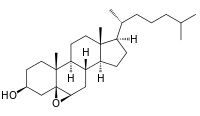Oxycholesterol
Oxycholesterol or 5,6-epoxycholesterol is a form of oxidized cholesterol implicated in atherosclerosis.[1] It is commonly formed from the reaction of fats and oxygen during high temperature cooking such as frying.
 | |
| Names | |
|---|---|
| Systematic IUPAC name
(3β,5β,6β)-5,6-Epoxycholestan-3-ol | |
| Identifiers | |
CAS Number |
|
3D model (JSmol) |
|
| ChemSpider | |
PubChem CID |
|
InChI
| |
SMILES
| |
| Properties | |
Chemical formula |
C27H46O2 |
| Molar mass | 402.663 g·mol−1 |
Except where otherwise noted, data are given for materials in their standard state (at 25 °C [77 °F], 100 kPa). | |
| Infobox references | |
In a study about the effects of Oxycholesterol in rabbits with induced hypercholesterolemia, it was shown that compared feeding rabbits cholesterol and unoxidized cholesterol, feeding rabbits Oxycholesterol caused there to be much higher levels of total cholesterol and LDL Cholesterol. It is also shown to increase the amount of HCY and ADMA levels in the rabbits. An abundance of HCY (Homocysteine) leads to an organism with greater chances of endothelial cell injury which can then lead to coronary artery disease. ADMA (Asymmetric dimethylarginine) is shown to cause adverse effects on humans in the form of cardiovascular and metabolic diseases. Therefore it was concluded that adding oxycholesterol into diets of animals with hypercholesterolemia increases endotheial dysfunction and inflammatory response.[2]
See also
- Oxysterol
References
- Physorg:Little known type of cholesterol may pose the greatest heart disease risk
- Wielkoszyński, Tomasz; Zalejska-Fiolka, Jolanta; Strzelczyk, Joanna K.; Owczarek, Aleksander J.; Cholewka, Armand; Furmański, Marcin; Stanek, Agata (2018). "Oxysterols Increase Inflammation, Lipid Marker Levels and Reflect Accelerated Endothelial Dysfunction in Experimental Animals". Mediators of Inflammation. 2018: 2784701. doi:10.1155/2018/2784701. ISSN 0962-9351. PMC 5866902. PMID 29713239.